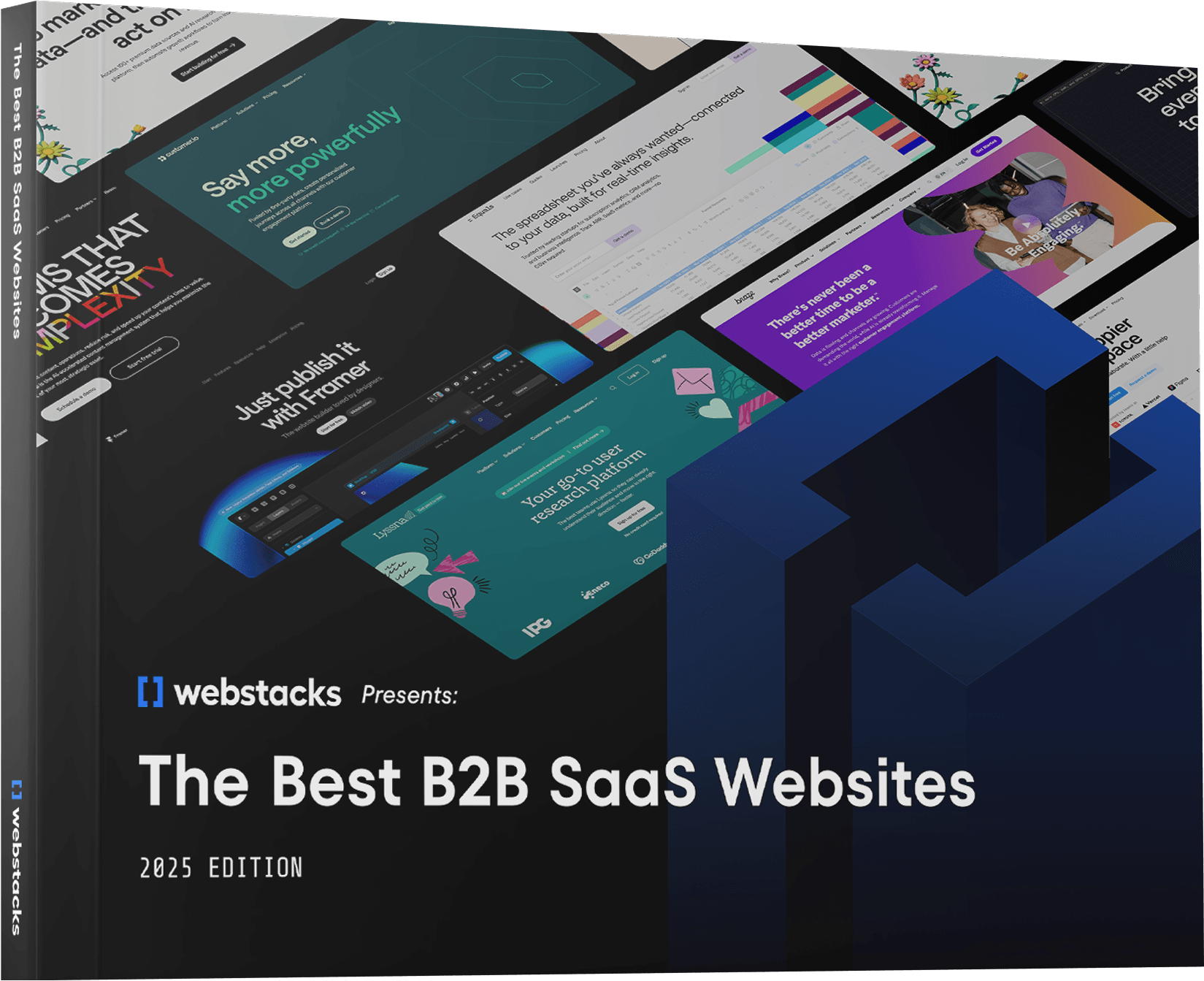Why Are Blogs Important for SaaS Websites?
A well-maintained blog is a cornerstone of any successful SaaS website. Blogs have evolved far beyond their original role as personal online diaries. Company blogs are now essential tools for driving traffic, educating users, establishing thought leadership, and converting leads.
This article explores why blogs are vital for SaaS websites and how they can be leveraged for maximum impact.
Blogs are an Effective Top of Funnel Marketing Strategy
At the top of the marketing funnel, blogs are a powerful tool to attract potential customers. For many B2B SaaS websites, a significant portion of organic traffic originates from blog content.
This is largely due to the potential for blogs to rank well in search engines, bringing in users searching for solutions or information related to your industry, in which they'd be directed to a SaaS solutions page (read our blog on what makes great SaaS solutions page design).
Once visitors land on your blog, you can guide them through the buyer’s journey. By strategically using content, SEO, and CRO (Conversion Rate Optimization) tactics, you can transform your blog into a lead-generation machine.
For example, well-placed call-to-actions (CTAs) within your content can prompt users to download a guide, sign up for a newsletter, or even request a product demo. Through consistent content and optimization, blogs can help nurture these leads, moving them closer to a purchase decision.

Blogs Establish Thought Leadership and Aid User Education
SaaS companies operate in competitive and rapidly changing industries. To stand out, it's essential to position your company as a thought leader. SaaS blogs offer a platform to share your insights, opinions, and expertise, helping to build trust with your audience.
Thought leadership isn't just about attracting attention—it's about becoming a go-to resource for valuable information, whether that's industry trends, product updates, or best practices.
Moreover, SaaS blogs serve an educational purpose. By providing detailed articles about your product, use cases, and industry-specific challenges, you help users understand how to make the most of your software. This educational content can help users make informed decisions, ensuring they extract the maximum value from your product.
Blogs Feed Your Social Media Content
One of the significant advantages of blogging is that it creates a steady stream of content that can be repurposed across various channels. Each blog post can be sliced into bite-sized pieces, such as quotes, infographics, or short video snippets, which can be shared on social media.
This not only increases the lifespan of your content but also drives more traffic back to your blog.
Social media sharing also amplifies your brand's visibility and awareness. As readers share your blog posts with their networks, you gain access to a broader audience, many of whom may not have discovered your brand otherwise. Over time, this can contribute to building a robust online presence and a community of engaged followers.
Blog Listing Page Design Considerations
A blog listing page serves as the gateway to your content, and its design plays a crucial role in user engagement. Consider the following design elements:
- Layout: Organize blog posts in rows and columns that make content easy to browse. Featuring a standout blog post at the top can draw attention to your most valuable content. Pagination ensures that users can easily navigate through older posts without overwhelming them with too much content at once.
- Categorization and Filtering: Offering categorization and filtering options allows users to find content on specific topics that interest them. This enhances user experience by enabling them to quickly locate relevant articles.
- Search Functionality: Implementing a search bar helps users find exact articles or topics by keywords, making it easier to locate specific content within your blog.
- Article Thumbnails: An eye-catching thumbnail image is often the first thing users notice. A compelling visual can entice readers to click on the article.
- Author, Date, Read Time, and Excerpt: Providing this information upfront gives readers context and sets expectations, helping them decide whether they want to invest time in reading the full article.
- Conversion Points: Adding CTAs like email captures for newsletter subscriptions or lead magnets (e.g., downloadable assets) can convert casual readers into leads.
- Responsiveness: Ensure that your blog listing page is fully responsive, providing a seamless experience across all devices and screen sizes.
Best Design Practices for a SaaS Blog Page
Designing a SaaS blog page that not only attracts visitors but also keeps them engaged is crucial for any SaaS company. Start by focusing on user experience (UX).
A clean, well-structured layout is key—consider using featured images, author names with headshots, and publish or update dates to make the content more approachable.
Adding a read-time estimate helps users gauge their time investment upfront, making the experience more user-friendly.
A table of contents is another great feature, especially for longer articles, as it allows readers to easily navigate to sections of interest. Breadcrumbs can further enhance navigation by showing users exactly where they are on the site, making it easier to explore other related content.
Social sharing buttons should be strategically placed to encourage readers to share your content across their networks, boosting visibility.
Formatting plays a significant role in readability. Use bullet points, bolded text, and lists to break up large chunks of text, making it easier for readers to digest information. Embedding social media posts, quote blocks, and relevant images or videos can also add variety and engagement to the content.
Lastly, responsive design is non-negotiable. Ensure your SaaS blog looks great and functions smoothly on all devices, from desktops to smartphones.
By prioritizing these design elements, your SaaS blog will not only look professional but also provide a seamless and enjoyable reading experience that keeps users coming back.

Designing with SEO Considerations
SEO should also be a major consideration when designing your blog page. Start by using clear, keyword-focused headings, especially in your H1 tag, to signal the main topic of your content to both users and search engines.
Metadata—such as URLs and meta descriptions—should be optimized with relevant keywords to improve search engine visibility. When it comes to images, always include alt tags that describe the content and compress the images to reduce page load times. Adding videos can increase the time users spend on the page and positively impact SEO.
Lastly, don’t forget the power of internal linking. Including a related content section at the end of your blog posts encourages users to explore more articles, improving the overall user experience and keeping visitors on your site longer.
By prioritizing these design and SEO considerations, your SaaS blog will look professional and rank better in search engines, driving more organic traffic to your site.
Optimizing Your Blogs for Conversions
A well-designed blog can be a powerful conversion tool. Here are strategies to optimize your blog for conversions:
Strategize Conversion Opportunities:
- Newsletter Subscription CTA: Encourage visitors to subscribe for updates directly from your blog.
- Downloadable Assets: Offer valuable resources like eBooks, reports, or checklists in exchange for contact information.
- Interactive Tools: Use assessments, calculators, or other tools to engage users and collect leads.
- Product Demos: Provide direct pathways to request a demo or trial of your product.
Add Conversion Points:
- Conversion Panels: Include sidebar panels or in-line CTAs for product demos or asset downloads.
- Slide-ins: Use non-intrusive slide-ins that appear as users scroll, offering valuable content or prompts.
- Pop-ups: Strategically timed pop-ups can capture attention without disrupting the user experience.
Do A/B Testing: Experiment with different designs, CTAs, and placements to determine what drives the best conversion rates.
Best SaaS Blog Design Examples
You now have a greater sense of how to take your blog’s design to the next level. Next, let’s take a closer look at B2B tech brands that have mastered these best practices and strategies.

Hotjar
Hotjar’s blog is thoughtfully structured, with categories tailored to specific use cases, customer stories, and industry insights. This clear segmentation allows users to quickly find relevant content, making the blog highly navigable. The focus on data-driven insights and success stories ensures that readers get valuable, actionable information that reinforces Hotjar's credibility in behavior analytics.
Other key design aspects:
- Clean and minimalist layout that prioritizes readability.
- Strong use of data-driven case studies.
- Engaging visuals and interactive elements.

ServiceTitan
ServiceTitan’s blog is designed to cater specifically to field service businesses, organizing content by industry and operational challenges. This targeted approach makes the blog highly relevant to its audience, providing practical advice and insights that help readers improve their business operations. ServiceTitan also uses a combination of customer stories and expert advice to position itself as a thought leader in the industry.
Other key design aspects:
- Industry-specific content categories.
- High-quality visuals and customer success stories.
- Clear CTAs driving towards further engagement with the brand.

Clickup
ClickUp’s blog stands out with its vibrant design and organized layout, offering a range of content that covers productivity tips, platform updates, and customer stories. The blog uses color-coded tags to help users quickly find relevant articles. ClickUp’s blend of educational content and product features ensures that users can maximize the value they get from the platform.
Other key design aspects:
- Vibrant design with color-coded tags for easy navigation.
- Balanced mix of educational content and product updates.
- Engaging visuals and use of dynamic elements.

Miro
Miro’s blog focuses on visual collaboration and creativity, with content that resonates with designers, teams, and remote workers. The layout is clean and modern, using visuals effectively to support the content. Miro’s blog also includes detailed guides and case studies that showcase how teams can use their platform to improve collaboration and innovation.
Other key design aspects:
- Visual-centric design that aligns with the platform’s focus on collaboration.
- In-depth guides and case studies for practical application.
- Clean and modern layout that enhances readability.

Aircall
Aircall’s blog is geared toward sales and customer support teams, with content that offers practical advice on improving communication and customer service. The blog is well-organized with categories that reflect the platform’s core offerings. Aircall also leverages testimonials and real-world examples to demonstrate the impact of its solutions.
Other key design aspects:
- Content categories that align with core service offerings.
- Use of testimonials and case studies to build credibility.
- Strong visual elements that complement the written content.

Grammarly
Grammarly, one of the best Edtech websites, is a great example of how to balance educational content with product promotion. The blog covers a wide range of topics, from writing tips to productivity hacks, all while subtly promoting Grammarly’s tools. The clean design and use of visuals keep readers engaged, and the content is easily shareable across social platforms.
Other key design aspects:
- Educational content that subtly promotes the product.
- Clean design with engaging visuals.
- Social sharing options that increase content visibility.

Calendly
Calendly’s blog is focused on productivity and time management, offering content that helps users optimize their schedules and workflows. The blog is organized into clear categories that reflect different aspects of scheduling and time management. Calendly also uses engaging visuals and interactive elements to keep readers engaged and provide a seamless user experience.
Other key design aspects:
- Focus on productivity and time management.
- Clear content categories for easy navigation.
- Use of interactive elements to enhance user engagement.

Planned
Planned’s blog targets event planners and marketers, with content that covers everything from event management tips to industry trends. The blog is visually appealing, with a modern design that highlights featured articles and popular topics. Planned also uses case studies and expert interviews to provide readers with valuable insights and actionable advice.
Other key design aspects:
- Modern design with featured articles and popular topics.
- Use of case studies and expert interviews.
- Visually appealing layout that enhances readability.

Pitch
Pitch’s blog is focused on helping teams create better presentations, with content that covers design tips, collaboration strategies, and platform updates. The blog is well-organized, with categories that make it easy for users to find relevant articles. Pitch also uses a combination of visuals and real-world examples to demonstrate the effectiveness of its platform.
Other key design aspects:
- Focus on presentation design and collaboration strategies.
- Organized categories for easy navigation.
- Use of visuals and real-world examples to support content.

Dropbox
Dropbox’s blog combines thought leadership with practical advice, offering content that helps users improve productivity and collaboration. The blog is organized into categories that reflect different aspects of work and technology, making it easy for users to find relevant articles. Dropbox also uses visuals and multimedia elements to keep readers engaged and enhance the overall user experience.
Other key design aspects:
- Thought leadership combined with practical advice.
- Organized categories that reflect work and technology.
- Use of visuals and multimedia elements to enhance engagement.

Closing Thoughts
A well-designed blog can be a powerful tool for a SaaS business. It not only drives traffic but also establishes thought leadership, feeds into social media content, and converts visitors into leads. However, content alone isn’t enough – a blog must be organized, designed, and optimized to provide an exceptional user experience that keeps readers engaged and moving toward conversion.




